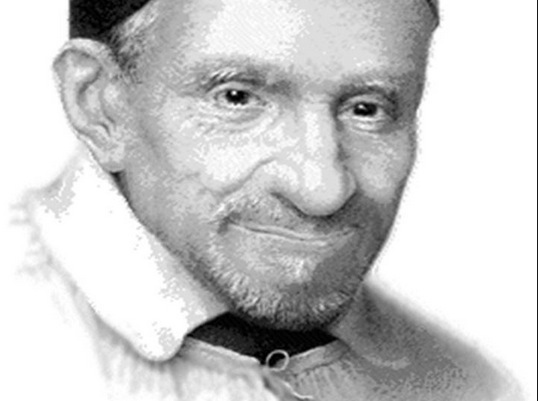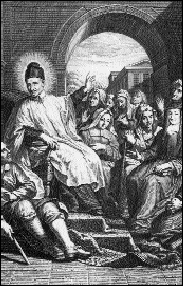 One of the key legacies of Vincent de Paul, is “personalism,” or respect for the person. What strategies did Vincent de Paul have for inclusive communication and decision-making? How do Wisdom and Vincentian personalism help support the mission and viability all mission-driven organizations?
One of the key legacies of Vincent de Paul, is “personalism,” or respect for the person. What strategies did Vincent de Paul have for inclusive communication and decision-making? How do Wisdom and Vincentian personalism help support the mission and viability all mission-driven organizations?
This issue is addressed in one of a series of articles presented by the Vincent on Leadership Hay Project at DePaul University. The following is based upon “Vincent and Tom Atlee: Strategies for Inclusive Decision-Making”
Tom Atlee, author of The Tao of Democracy: Using Co-Intelligence To Create A World That Works For All to explore these questions around wisdom, inclusive communication and decision-making, and viability.
Wisdom in Practice
Atlee says the more diverse the people engaged in these wisdom conversations are, the better. “That fact that different people have different experiences and perspectives suddenly becomes a resource for developing wisdom,” writes Atlee.
Here is what Tom Atlee says about wisdom and its characteristics:
Characteristics of Wisdom
Some of the hallmark characteristics of wisdom offered by Atlee are:
Wisdom embraces the BIG PICTURE — in any situation, it seeks to take into consideration the long term, the full story, both objective and subjective worlds, holistic and system sciences, Spirit, context, and other deep, broad realities.
Wisdom uses MULTIPLE WAYS OF KNOWING — for example, it uses heart, intuition, story and spirit as well as facts and reason — and often arises out of authentic dialogue among diverse people or perspectives.
Wisdom is INCLUSIVE AND OPEN — to diversity, novelty, otherness, nuance, disturbance, and other things that are often ignored, excluded or suppressed, thus being particularly fair and comprehensive in its approaches and mindful that “there is always more to it than that.”
Wisdom is INSIGHTFUL AND APPROPRIATE — even as it is inclusive and vast in its embrace of reality, it cuts to the essence of what needs to be understood in a situation — the most relevant realities that need to be worked with — particularly the underlying dynamics, the hidden resources (often masquerading as problems) and the long-term consequences.
Wisdom is HUMBLE AND RECEPTIVE — recognizing the limitations and relativity of all perspectives and knowledge, it tolerates (and even appreciates or surrenders to) uncertainty, paradox, mystery and complexity, and so is able to entertain (and is often interested in dialoging with and learning about) diverse viewpoints, information and possibilities, while being unattached to any particular one, disinclined to blame and lighthearted about the efforts of life.
Wisdom SERVES LIFE — caring for and appreciating the sacredness (or unique integrity and value) of all beings and living systems, it tends to focus on where life (and passion) are most vivid, and on what is important for life’s healing and flourishing, and so it tends to produce (or catalyze) broadly beneficial outcomes.
Wisdom is GROUNDED IN RELATIONSHIP — appreciating, practicing, embodying and nurturing interconnectedness among all things, it serves harmony, balance, dialogue, co-evolution and healthy feedback that supports and creatively uses diversity and authenticity.
Wisdom has an ELEGANT SIMPLICITY — using no more (resources, words, force, etc.) than necessary and often economizing through cooperation (seeing problems as resources and enemies as allies) and elegant alignment with the realities of the situation.
Wisdom has INTEGRITY — embodying courageous commitment to truth — particularly one’s truth to oneself and one’s experience — which can manifest as steadfastness or flexibility, depending on where the alliance with truth leads.
Wisdom has PRESENCE — a hard to define but compelling quality of imminent, centered, mature realness that is grounded in deeper/higher realities (such as experience, Spirit and silence) and so naturally evokes respect, resonance, trust, and the stirrings of greater Life.
Portrait of Vincent as a Wise Leader
 Using Tom Atlee’s list of characteristics as our criteria, in what ways did Vincent de Paul exhibit the practices of a wise leader? Those familiar with Vincent will recognize from his writings and teachings some of the wisdom characteristics he both espoused and lived, such as simplicity, humility, integrity, and service.
Using Tom Atlee’s list of characteristics as our criteria, in what ways did Vincent de Paul exhibit the practices of a wise leader? Those familiar with Vincent will recognize from his writings and teachings some of the wisdom characteristics he both espoused and lived, such as simplicity, humility, integrity, and service.
As for Atlee’s suggestion that wise leaders have a sense of the “big picture,” the following quote would suggest that Vincent demonstrated this characteristic, suggesting that every endeavor be carefully examined within its broader context: “We must receive with respect whatever God presents to us, and then examine the situation with its circumstances in order to do what is most expedient.”
Alison Forrestal describes Vincent at Saint Lazare reflecting on the successful growth of the Congregation of the Mission,the Ladies of Charity and the Daughters of Charity echoes Atlee’s description of the wise leader’s embrace of the big picture:
When Vincent de Paul gazed outward from Saint Lazare in the twilight of his long career, how did he explain this dramatic and sustained growth? He would surely have assumed that divine providence was the principal architect of the steps and events that had enabled the three organizations to emerge initially, to expand, and to consolidate. As he consistently reminded himself and others, the fate of humans, their institutions, and their work remained entirely in the gift of providence. This, he believed, was the fundamental maxim of faith that gave direction and purpose to his own life, the lives of his confreres, and the work of the Congregation and its fellow associations of charity.
Forrestal also notes that in a conference with the Daughters in 1647, Vincent coached them to assess any given choice by looking at it with three factors in mind: in what way the choice contributed to God’s glory, the interest of the Daughters, and the welfare of the interested parties.
Vincent’s wisdom and inclusive leadership style also are evident in his relationship with Louise de Marillac, with whom he co-founded the Daughters of Charity. As Forrestal observes:
Rather than simply being a dogmatic authority, their dialogues indicate that he acted primarily as a constantly available source of honest spiritual and practical advice, who encouraged Louise to trust her ability to initiate, judge, and supervise. Importantly, Vincent earned Louise’s respect for his opinion by his generous availability, frankness, and edifying example of piety and leadership; this proved just as influential as the existence of a formal constitutional link between their organizations.
Vincent as Inclusive Decision-maker
We also know that Vincent was very “inclusive and open,” moving freely and genuinely among the poorest of the poor, and also among the very wealthy. He also never let theological differences keep him from respecting the human dignity of others.
Vincent also promoted diversity and quality dialogue. As Fuechtmann notes, “For Vincent, the style of communications in meetings should be clear and forthright. Participants should be confident in presenting their own insights, but in an objective and ‘businesslike’ manner.”
In a presentation to the Daughters of Charity in 1653, reported by Fuechtmann,Vincent offers instructions for how to approach a potentially conflictual conversation. Vincent’s advise sounds quite similar to what one might hear at a workshop on listening and communication skills today. Vincent instructed:
“(W)hen called to the meetings to giver our opinion, we should first recommend this to God, and, when questioned, be prepared to answer as follows: ‘I’m of such an opinion for such and such reasons.’ …If another Sister has spoken before you and her opinion is different from yours, you must reply to the reason she has suggested by giving other reasons, and say, ‘As to hat has been mentioned, which is such or such a thing, I’d like to respond with such or such a reason.’”
Finally, we have this quote from Vincent about his choice to consult with his colleagues in ministry when making decisions that affecting the whole:
“I often consult even the Brothers and ask their advice on questions involving their duties. When this is done with the necessary prudence, the authority of God … is in no way disadvantaged. On the contrary, the good order which ensues makes it more worthy of love and respect.”
Though more research can further develop this portrait, it is possible from these few examples to see how utilizing the writings of Tom Atlee can help us begin to develop a portrait of Vincent de Paul as a wise and inclusive leader, and inspire us to the same.
A Formula for Wisdom Dialogues
One practical way to begin to improve our own leadership might be to experiment in our own organizations with what Atlee offers as a formula for developing inclusive conversations that lead to wisdom.
Tom Atlee offers the following as the simple basics for the design for promoting inclusive, high quality conversation and better decisions:
a) Officially convene a group whose diversity is a fair sample of the larger population concerned. Their typical diversity provides the challenges they need to expand their individual perspectives to embrace the bigger picture held and/or needed by the whole community.
b) Ensure they have high-quality information and high quality conversation in which everyone feels heard, all contributions can find their proper place, and group creativity is engaged. This ensures their diversity does, in fact, produce more light than heat — generating more useful wisdom than anyone could generate by themselves.
![]() c) Hardwire their dialogue and their findings into broader public dialogue and official political/governmental processes. If the process is set up so that the broad public takes notice, they’ll talk about the results. The public will come to expect politicians and officials to pay attention to what “The People” have to say. If it is plugged into official decision-making processes, all the better.
c) Hardwire their dialogue and their findings into broader public dialogue and official political/governmental processes. If the process is set up so that the broad public takes notice, they’ll talk about the results. The public will come to expect politicians and officials to pay attention to what “The People” have to say. If it is plugged into official decision-making processes, all the better.
Reflection Questions:
Do you remember a situation in which you stepped forward to provide leadership?
How did you help people make a decision together?
What stories have you heard about Vincent de Paul and his style of communication and decision-making?
Who for you stands out as someone who is a “wise” person?
Would you describe Vincent as “wise’? If so, what characteristics come to mind?
What stands out for you as most significant in this strategy for inclusive decision-making proposed by Atlee?
How could you begin to adapt and utilize this strategy in your own workplace?
Resources
Forrestal, Alison. “Vincent de Paul: The Principles and Practice of Government, 1625-60,” in Vincentian Heritage Journal (Chicago: DePaul Publications Group, 2009), Vol 29:51. Used with permission.
Fuechtmann, Thomas G. “There Is Great Charity, But…” in Vincentian Heritage (Chicago: DePaul Publication Group, 2005), Vol. 23-25. Used with permission.







0 Comments